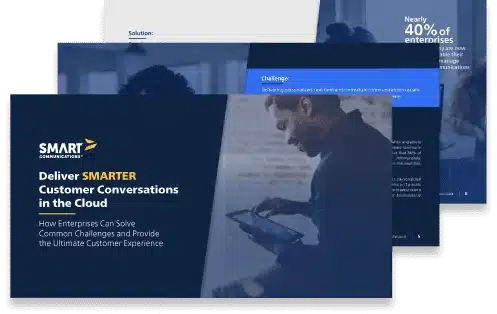Situations Change, So Too Must Your Processes
By: Nick Smith, VP Sales & General Manager, APAC at Smart Communications
In the digital era, there’s no shortage of data. Most organizations in both the private and public sectors have an abundance of it—in fact, many have more than they know what to do with. According to a recent survey, 55% of data that companies collect goes unused.1
Not just data, insights
Getting the most out of your data starts with how you collect it. While many organizations have moved away from relying solely on outdated paper-based processes, simply becoming more digital-first doesn’t necessarily mean you’re making the most of the process. Static forms and generic questions only provide point-in-time snapshots of the people submitting them. While this information is useful at that moment, its value is limited because that data soon becomes outdated. In order to gain more valuable insight organizations need to transform one-way intake processes into two-way conversations.
Agility in action
Most organizations collect at the outset of the relationship, but many fail to continually update the information they have on file. However, needs and preferences change every day, and companies need to stay one step ahead in order to stay relevant. For government organizations, educational institutions, and healthcare companies, it’s even more vital to have data that’s current, which means users need an easy way to update their information.
This recently came into play for the Australian National University (ANU). With 25,000 students, approximately one-third of them international students, the onset of the COVID-19 crisis called for immediate action. The University needed to quickly gather important circumstantial information that would help them provide vital support as well as minimize the potential health impact on their community. ANU formed a crisis management team and, using SmartIQ, very quickly distributed a smart form to all international students to inquire about recent travels and what support they would need in order to stay safely engaged with their learning community.
And when it became clear to ANU that a broader lockdown would be put in place, they expanded the process to include all students, with the goal of enabling targeted communications and support based on immediate needs—from health status and access to groceries for anyone self-isolating, to housing needs and access to the internet and online learning materials.
The University recognized that student needs were likely to change just as the situation was evolving. ANU students were able to return to the smart form and update their answers as circumstances changed—for example, once they completed a self-isolation period, when they reached their destination, or when their access to the internet changed. Especially in a time of rapid change and increasing uncertainty, it is vital for respondents to be able to update their information as needed.
Better insights, better outcomes
While we have known for some time that digital transformation and more customer-centric processes were necessary, the events of this year have significantly increased the need for organizations to find better ways to collect information and use that information to deliver exceptional experiences throughout the relationship. The forms process of the past must be transformed into adaptive, intelligent conversations that allow for flexibility and deeper insight. And they must be digital-first, mobile-friendly and frictionless.
Ideally, the lessons learned in 2020 will continue well beyond the return to the new normal. When you get to know people better, you’re able to serve them better. And transforming static processes into interactive, two-way conversations at scale, is an excellent way to start.
- Priceonomics, 2019: “Companies Collect a Lot of Data, But How Much Do they Actually Use?”



